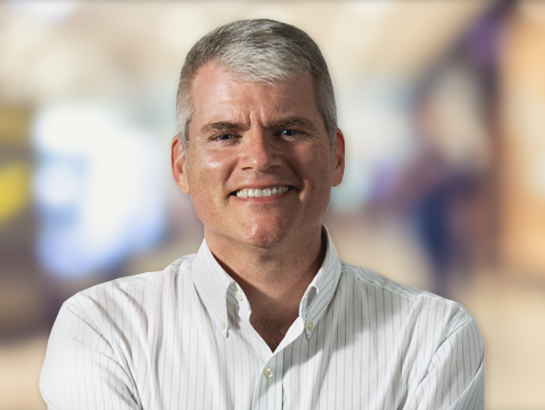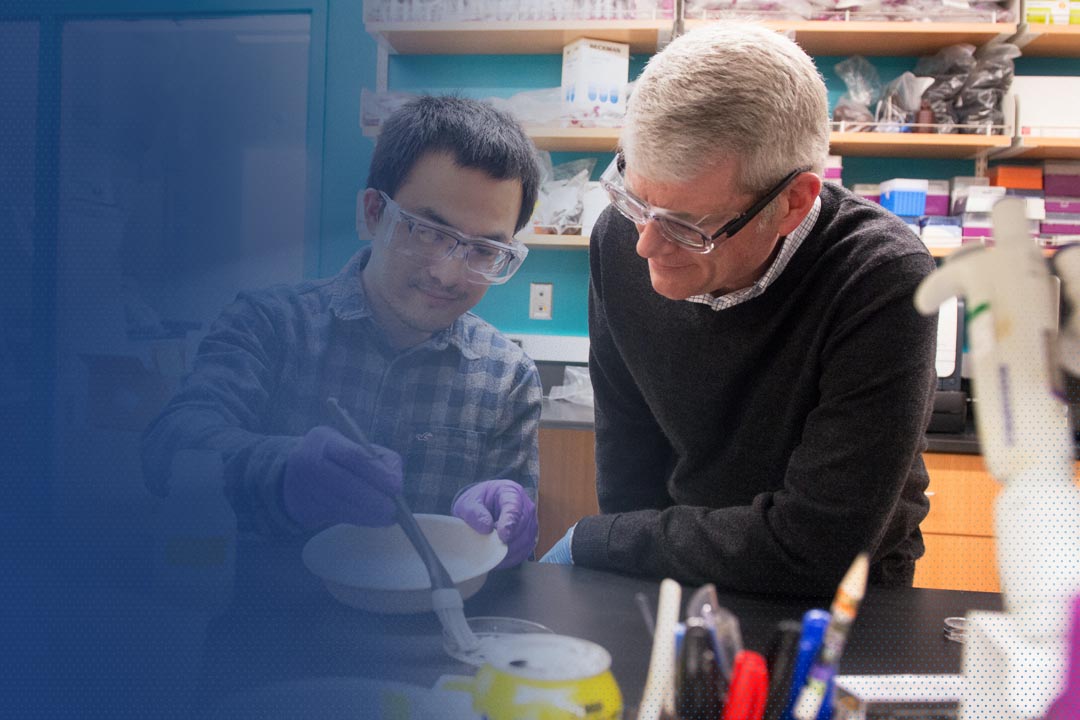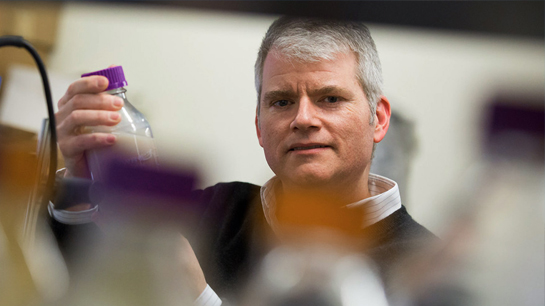Jeffrey Catchmark just wanted to re-engineer styrofoam cups. He combined starch from potatoes and chitosan from shellfish to create a unique foam to replace disposable containers in the foodservice industry. The market for such a product turned out to be narrow, but elsewhere in this top-25 research university, Dr. Scott Armen, chief, Division of Trauma, Acute Care and Critical Care Surgery at Penn State Health Milton S. Hershey Medical Center, saw a different use. The material is bioabsorbable, soft and resilient, meaning the foam can be placed within traumatic wounds like gunshots, shrapnel cuts, and other deep wounds to stop bleeding and stabilize the patient. Together they hope to produce a to-go pack of the foam that can be easily carried and used in the field.

Jeff Catchmark, professor of agricultural and biological engineering, College of Agricultural Sciences
Impact
Because your answers could solve someone else’s problems.
“Through this discovery process, we’ve learned that despite what we thought we were looking for, what we ended up finding is something with much broader impact.”
Portable Treatment Options
Catchmark and Dr. Armen have developed a biofoam pad that could replace cotton bandages and revolutionize wound treatment. The biofoam could be useful in treating wounds in surgical, military, and veterinary fields, as well as a way to reduce plastics pollution worldwide.
The team hopes to produce a portable pack of the biofoam in a variety of shapes to quickly stabilize any number of wounds. The pack could be easily carried and used in the field by emergency responders and military medics.
The unique foam material absorbs blood and body fluids, expands to put pressure on a wound, conforms to the wound’s shape and doesn’t stick to tissue. Once applied, the foam’s surface transitions to a gel that promotes healing and can be left inside the body. The foam can be placed within traumatic wounds like gunshots and shrapnel cuts to stop bleeding and stabilize the area until the patient can be taken to a medical facility.
“After the wound is healed and you remove the bandage, some of that gauze might be embedded in the tissue. If you pull at the gauze, it disturbs the healing tissue. Ideally, you’d like to have a material that facilitates the healing process but also vanishes,” Catchmark said. “One of the reasons that this approach works is because the bio-absorbable material degrades into glucose. The glucose just becomes a part of the sugars in the blood stream.”
Catchmark says that opportunities to collaborate with researchers like Dr. Armen has been invaluable in producing these new materials.
“Because Penn State has an outstanding culture of interdisciplinary research, engineers, scientists, and medical doctors can work together here effortlessly,” Catchmark said. “Penn State understands and supports interdisciplinary collaboration. It is simply the most effective path toward discovery.”
At this time, the material is still in development and more research is needed on its effectiveness. Catchmark and Dr. Armen are currently collaborating on a three-year, $1.4 million grant from the U.S. Army Medical Research and Development Command to further test the foam for battlefield uses.
“We are hopeful that it will become an important product in the wound treatment space in the future,” said Catchmark.
“One of the most rewarding experiences of my research is being able to translate scientific discovery into something that helps the world, and Penn State is an immeasurably supportive place for making that happen.”

Creating a Sustainable Future
In addition to being used for wound treatment, Catchmark’s biomaterials could also lead to eco-friendly products such as compostable food containers and replacements for the plastic microbeads in cosmetic products, which often end up in oceans, lakes, and rivers.
“With this research, there’s potential to remove tens of millions of tons of plastic from our waste stream,” Catchmark said. “I’m really motivated by the opportunity to develop materials that can help humanity become more compatible with our ecosystem.”
Catchmark has always been interested in sustainability—so much so that in 2002 he decided to switch fields from electrical to biological engineering.
“As I’ve gotten older, I’ve learned to be more purposeful about how I spend my time,” Catchmark said. “Looking at the work I was doing, I felt like I was a step removed from seeing any tangible impact my research could have on the world. Being a nature lover, I wanted to focus on ways my research could impact sustainability, and I couldn’t do that by working on lasers.”
Now, seventeen years later, Catchmark’s collaboration with fellow materials scientists and colleagues like Dr. Armen is helping bring that impact to fruition.
“One of the most rewarding experiences of my research is being able to translate scientific discovery into something that helps the world,” Catchmark said. “And Penn State is an immeasurably supportive place for making that happen.”

In April 2018, Catchmark received the Research Innovators Award from Penn State’s College of Agricultural Sciences (Penn State News, April 5, 2018). The award recognizes faculty and staff who have commercialized technologies generated through Penn State research. Catchmark received the award for his work translating materials science research into patented commercial solutions.


